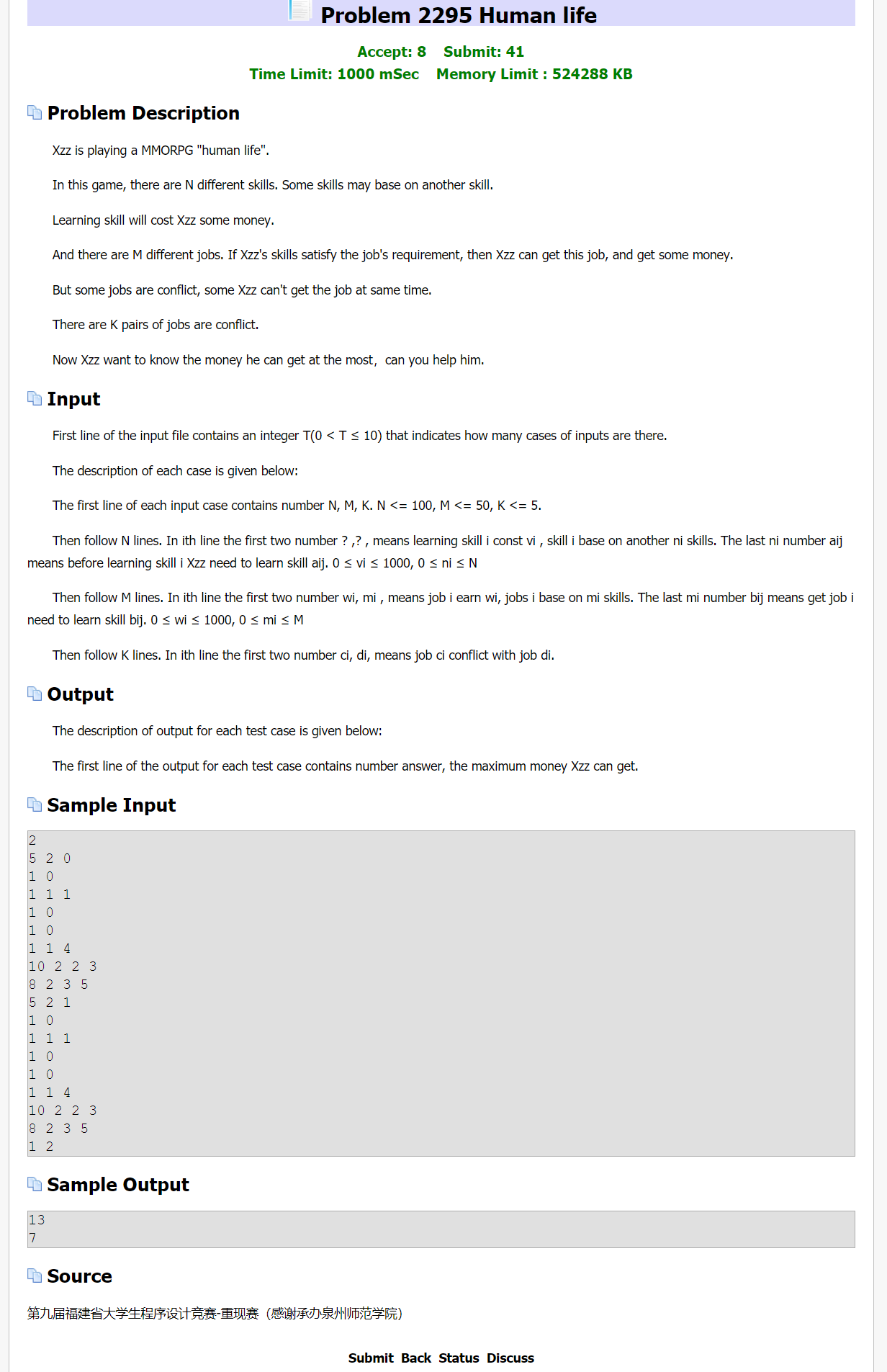(有任何问题欢迎留言或私聊 && 欢迎交流讨论哦
http://acm.fzu.edu.cn/problem.php?pid=2295
http://acm.fzu.edu.cn/problem.php?pid=2295
Catalog
Problem:Portal传送门
原题目描述在最下面。
题意就是很裸的最大权闭合子图。
推荐阅读:胡伯涛《最小割模型在信息学竞赛中的应用》
完完全全的模板题:新疆大学五月月赛-D-勤奋的杨老师
本题题意:m(50)个任务,n个技能。完成每个任务由相应的收益,完成每个任务前必须学一些技能。有些技能由先修技能。
有些任务不能同时完成。
Solution:
训练赛的时候听队友讲完题意,一眼就直接建对图了,但是没敢敲,因为比赛刚开始,想先写签到题。
详细de题解啊啊啊
直接讲建图:源点S想每个任务连边,流量为其收益,每个任务向其需要的技能连边,每个任务向先修技能连边,每个技能向汇点T连边,流量为其花费。答案是(sum_{任务}-maxflow).
难点在于有些任务不能同时完成。因为只有k(5)对,直接二进制枚举所有对互斥情况。为1则不能选第一个任务,为0则不能选第二个任务。不选就是取反再异或一下。
细节看代码吧。
AC_Code:
#include <cstdio>
#include <cstring>
#include <iostream>
#include <queue>
#define mme(a,b) memset((a),(b),sizeof((a)))
using namespace std;
typedef long long LL;
const int INF = 0x3f3f3f3f;
const int MXN = 2e2+7;
const int MXE = MXN*MXN;
struct DINIC{
int tot,vt,vs;
int d[MXN],head[MXN];
struct lp{
int v,w,nex;
}cw[MXE];
void add_edge(int a,int b,int c){
cw[++tot].v=b;cw[tot].nex=head[a],cw[tot].w=c;
head[a]=tot;
cw[++tot].v=a;cw[tot].nex=head[b],cw[tot].w=0;
head[b]=tot;
}
bool bfs(){
memset(d,-1,sizeof(d));
queue<int>Q;
Q.push(vt);d[vt]=0;
while(!Q.empty()){
int u=Q.front();
Q.pop();
for(int i=head[u];i!=-1;i=cw[i].nex){
int v=cw[i].v;
if(cw[i^1].w&&d[v]==-1){
d[v]=d[u]+1;
Q.push(v);
}
}
}
return d[vs]!=-1;
}
int dfs(int x,int f){
if(x==vt||f==0) return f;
int use=0,w;
for(int i=head[x];i!=-1;i=cw[i].nex){
int to=cw[i].v;
if(d[to]==d[x]-1 && cw[i].w){
w=dfs(to,min(cw[i].w,f-use));
cw[i].w-=w,cw[i^1].w+=w;
use+=w;
if(use==f) return f;
}
}
return use;
}
void init(int st,int ed){
tot = -1;
memset(head,-1,sizeof(head));
vs = st; vt = ed;
}
int max_flow(){
int ans=0;
while(bfs())ans+=dfs(vs,INF);
return ans;
}
}dinic;
const int N = 105;
int n, m, k;
int vs, vt;
struct lp{
int v,x;
int a[N];
}ar[N],br[N];
int c[N],d[N];
int main(){
int tim;
scanf("%d", &tim);
while(tim--){
scanf("%d%d%d", &n, &m, &k);
vs = 0;vt = m+n+1;
for(int i = 1; i <= n; ++i){
int v,x;
scanf("%d%d", &v, &x);
ar[i].v=v;ar[i].x=x;
for(int j = 0; j < x; ++j){
scanf("%d", &ar[i].a[j]);
}
}
for(int i = 1; i <= m; ++i){
int v,x;
scanf("%d%d", &v, &x);
br[i].v=v;br[i].x=x;
for(int j = 0; j < x; ++j){
scanf("%d", &br[i].a[j]);
}
}
for(int i = 0; i < k; ++i){
scanf("%d%d", &c[i], &d[i]);
--c[i];--d[i];
}
int sta = 1 << k, ans = 0;
//printf("%lld
", 1<<50);
for(int t = 0; t < sta; ++t){
LL hhh = (1LL<<m)-1;
for(int i = 0; i < k; ++i){
LL x = 1LL<<c[i], y = 1LL<<d[i];
if(t&(1<<i)){
hhh &= (~x);
}else{
hhh &= (~y);
}
}
//printf("hhh = %d
", hhh);
dinic.init(vs, vt);
for(int i = 1, v; i <= n; ++i){
dinic.add_edge(i+m,vt,ar[i].v);
for(int j = 0; j < ar[i].x; ++j){
v = ar[i].a[j];
dinic.add_edge(i+m,v+m,INF);
}
}
int sum = 0, tmp;
for(int i = 1, v; i <= m; ++i){
if((hhh&(1LL<<(i-1)))==0)continue;
dinic.add_edge(vs,i,br[i].v);
sum += br[i].v;
for(int j = 0; j < br[i].x; ++j){
v = br[i].a[j];
dinic.add_edge(i,v+m,INF);
}
}
tmp = dinic.max_flow();
ans = max(ans, sum - tmp);
}
printf("%d
", ans);
}
return 0;
}
####Problem Description: 